This year, 2024, marks the 25th anniversary of arc-fault circuit interrupters (AFCIs) becoming a National Electrical Code® (NEC®) requirement. The device was created following a national call for increased electrical safety and electrical fire prevention. It was a large collaborative effort between the consumer protection, fire safety and electrical industries to provide a solution that utilized electrical expertise, fire prevention technologies, improved construction materials and fire service response strategies. Today, AFCIs and these combined efforts have helped to significantly decrease the number of residential electrical fires in the U.S.
by NEMA LVDE AFCI Task Force
Electrical contractors, inspectors, homebuilders, and others have played an important role in the development and application of this technology. AFCI devices detect dangerous arcing in the premises wiring system and then immediately de-energize the circuit to prevent a potential fire before it can start.
To understand just how important our current level of electrical and fire protection is today, 25 years later, it involves looking back to what was occurring in homes in the early 1980s.

Increasing Fires & The Need for A Solution
Per the National Fire Protection Association, home structure fires reached a peak of 75,000 fires annually in 19801.
That same year, the United States Fire Administration (USFA) commissioned a fire loss comparison study that showed the U.S. suffered one of the world’s highest death rates from fire – two to four times higher than experienced in European countries2. Approximately three-fourths of those deaths occurred in residential fires. Furthermore, the study concluded that “fires in residential electrical distribution systems are an important contributor to this problem.”3
The Consumer Product Safety Commission and USFA later found electrical fires occurred most often in branch circuit wiring, followed by receptacle outlets and extension cords. Underwriters Laboratories (UL Solutions) concluded in September 1995 that “from the technologies analyzed, arc-fault detection appeared to be very promising, especially when added to residential branch-circuit breakers and combined with other proven technologies such as ground-fault protection.”4
Additional CSPC research indicated by the late 1990s more than 40,000 fires were being attributed annually to home electrical distribution systems. The fires resulted in more than 300 deaths and over 1,400 injuries each year. Statistics from 1992-1996 showed level trends in each of these estimates with no indications of decline. In 1996, $680 million in property loss was attributed to home electrical distribution fires.5
AFCI Technology Emerges
UL® and the National Electrical Manufacturers Association (NEMA) would next collaborate on the creation of a draft standard defining a set of operational requirements for AFCIs in December 1996.6
Armed with extensive research, data, and standards, it was now time for electrical manufacturers to engage and begin designing and producing AFCIs for circuit breaker box installation.
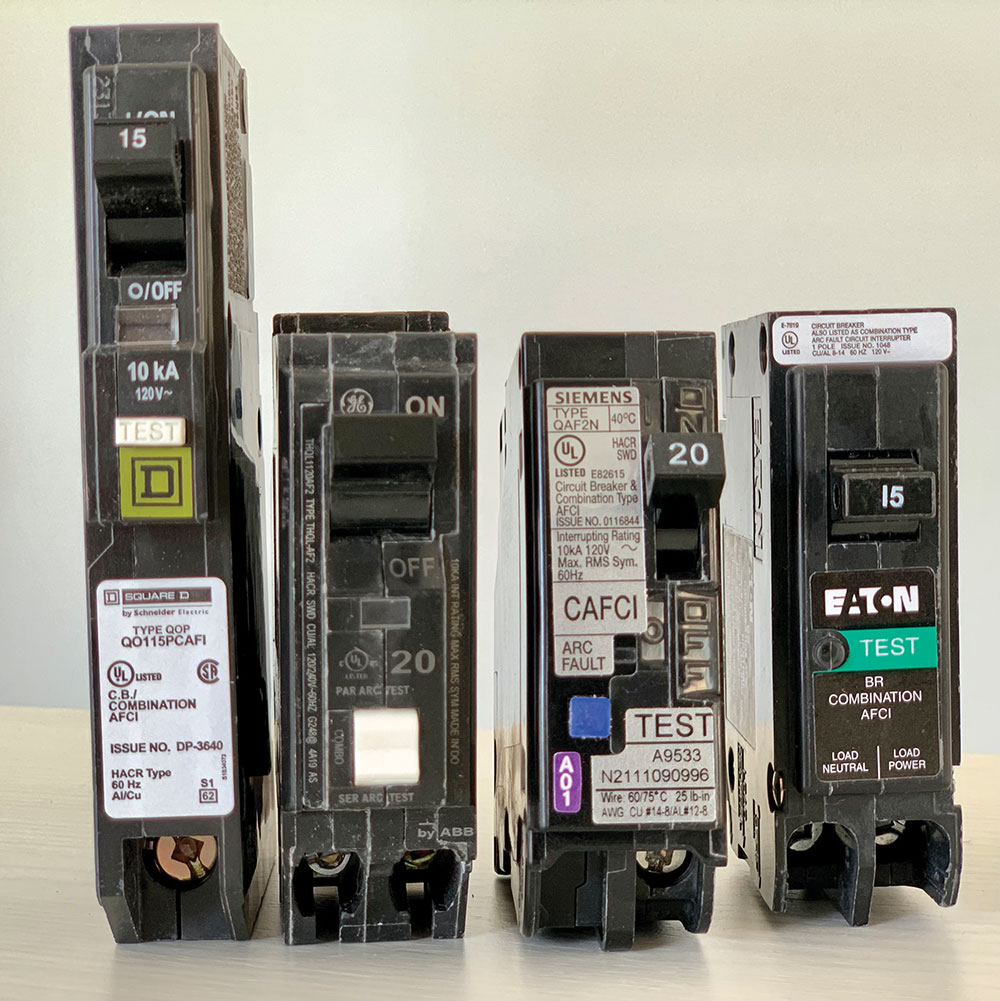
While the devices from multiple manufacturers looked a little different then as they do now, all complied with a newly established UL® Standard for AFCIs (UL 1699), which defined an arcing fault as an unintentional arcing condition in a circuit.
This is the type of arcing that creates high-intensity heating at the point of the arc, resulting in burning particles that may, over time, ignite surrounding material, such as wood framing or insulation. The temperatures of these arcs can exceed 10,000 degrees Fahrenheit. Repeated arcing can create carbon paths that are the foundation for continued arcing, generating even higher temperatures. Unlike a standard circuit breaker detecting overloads and short circuits, an AFCI utilizes advanced electronic technology to “sense” the different arcing conditions. While there are different technologies employed to measure arcs by the various AFCI manufacturers, the end result is the same: detecting parallel arcs (line to line, line to neutral, and line to ground) and/or series arcs (arcing in series with one of the conductors) and de-energizing the circuit to prevent a fire.
The CSPC estimated AFCI technology could prevent 50% or more of electrical fires.8
With the support of the electrical, consumer, and fire protection communities, AFCIs entered into construction and renovation use in 1999, officially becoming a 1999 NEC® requirement for AFCIs to be used with single-phase 15A and 20A branch circuits serving bedroom branch circuit outlet receptacles effective in the year 2002. Although the first NEC® requirement applied only to new residential construction, AFCIs could be used for installation in existing homes as well. Older homes with aging and deteriorating wiring systems could especially benefit from the added protection of AFCIs.9
Establishing AFCIs as an NEC® requirement in 1999 was significant. The technology met the safety threshold with a rigorous review by electrical and NFPA experts to become a requirement. It also firmly established the commitment to safety being made by not only the consumer safety, fire services, and electrical industries but also those in the field responsible for installation and oversight, including electrical contractors, builders, and inspectors. The NFPA 70®, NEC® published by the National Fire Protection Association (NFPA), is recognized as a worldwide standard for electrical safety and sets the foundation for electrical safety in residential, commercial, and industrial occupancies.10

NEC Code Adoption and AFCI Expansion
Decades ago, a National Fire Protection Association Fire & Life Safety analysis indicated – “The most successful recipe for fire safety in the built environment is the implementation of fire safety technologies through mandated codes and standards.” 11
Over the years and through various code adoption cycles, the NEC®’s AFCI requirements for homes have been expanded, moving beyond bedrooms into living rooms, dining rooms, sunrooms, and other gathering places, including kitchen and laundry areas, as required in the 2023 NEC®. Additionally, AFCI protection is also now required for sleeping quarters in such dwellings as police, fire and ranger stations, in addition to previous requirements for hotels, dormitories and others.12
NFPA’s codes and standards system continues to help improve electrical and construction safety through code cycles. The NFPA monitors NEC® adoption on its website https://www.nfpa.org/education-and-research/electrical/nec-enforcement-maps?l=50. Each state offers its own code adoption process utilizing the NEC® in typical three-year cycles via electrical and fire experts on committees, boards, commissions and/or through legislative review/approvals.
In 2018, the NFPA’s Fire & Life Safety Policy Institute reported increasing concerns about costs associated with code compliance requirements often dominated discussions [within the process]. Not unlike other new technologies and electrical/building requirements, AFCIs have faced similar challenges. While the technology is more expensive than a standard circuit breaker (around $40 per unit), AFCIs are still affordable compared to other home building expenses and are especially important to provide critical protection to residential occupants from potential electrical fires that can cause injuries, death, and property damage. AFCIs will protect a 2,000-square-foot, four-bedroom home and its occupants from electrical fires for around $300 or less than 83 cents per month over the course of a 30-year mortgage.13
Per the NFPA report, code requirement costs need to be carefully measured against the life safety protections the improvements provide:
“…while benefits are more difficult than costs to quantify, they should not be ignored. Most states are not considering the safety benefit alongside the cost. Every year, electrical-related fires are responsible for over $2 billion in direct property losses and are responsible for an average of 61,000 fires, resulting in 432 deaths. Improvements made through the code are an important means for reducing these losses.’” 14
AFCI Improvements & New Data
Over 25 years, AFCIs, like other safety and construction technologies have continued to improve through design or application. Awareness and educational efforts within the electrical contractor, builder, inspector and fire service industries have helped increase understanding of the technology, its installation, use and addressing any potential issues.
An early concern when AFCIs first came to market were occasional reports of false tripping. Follow ups by contractors and manufacturers almost always showed the devices were working as designed, meaning they tripped due to detecting potentially dangerous arcing in the circuit. Recently, a 2023 survey conducted by the Electrical Safety Foundation International (ESFI) in Colorado, Georgia, Kentucky, Minnesota, Ohio, Texas, and Washington surveyed contractors with experience in electrical contracting, design, and engineering regarding AFCIs and GFCIs. They reported that roughly 58% of their service calls involved tripped breakers or fuses in homes. Of those calls, only 17% reported a tripped AFCI breaker, and 100% of the contractors indicated they saw evidence of dangerous arcing when responding to an AFCI-related service call. All of the contractors determined the devices were working as intended. The trips identified and prevented serious problems that could have otherwise resulted in injuries or the potential loss of life and property.15
NEMA offers electrical contractors and consumers an ongoing opportunity to report any AFCI tripping concerns online at https://www.afcisafety.org/home-owners/unwanted-tripping-report/.
The compatibility of AFCIs with home appliances has also been a topic of discussion over the years in the electrical industry. The National Association of Home Builders (NAHB) publishes the number of one- to two-family homes and multi-family units built within the U.S. on a state-by-state basis. According to NAHB data, there were over 11 million dwelling units built since 2014. Over 9.5 million of those dwelling units were built in states where a majority of cord/plug appliances are protected by AFCIs.
In a white paper released in 2023 by NEMA’s Low Voltage Distribution Section, new data and research were presented on the topic. Entitled Arc Fault Circuit Interrupters and Home Appliances, it focused specifically on 15A and 20A AFCI protection of branch circuits utilized by cord and plug-connected appliances.16
Per the paper, not only are AFCIs working well with various appliances, but they are doing so consistently. More than 60 million home appliances are estimated to now be protected by AFCIs nationwide. Examples of the percentage of homes containing specific appliances are dishwashers (56%), refrigerators (83%), microwaves (84%), vacuums (76%), and washing machines (74%).
NEMA indicated AFCI manufacturers conducted more than 130,000 interoperability tests with a variety of appliances and appliance combinations. The tests included 400 appliance brands and 150 product types. Additional testing was done for over 40,000 combination loads, such as various countertop appliances, vacuum cleaners, power tools, and durable medical equipment. The lab tests used loading, temperature, humidity, and other factors to change the parameters to provide as many options as possible to determine if an AFCI would trip when protecting the circuit where an appliance or group of appliances are installed. The results of the extensive tests were that AFCIs function properly with appliances.
Figures 1, 2, and 3. Appliances. Courtesy of NFPA
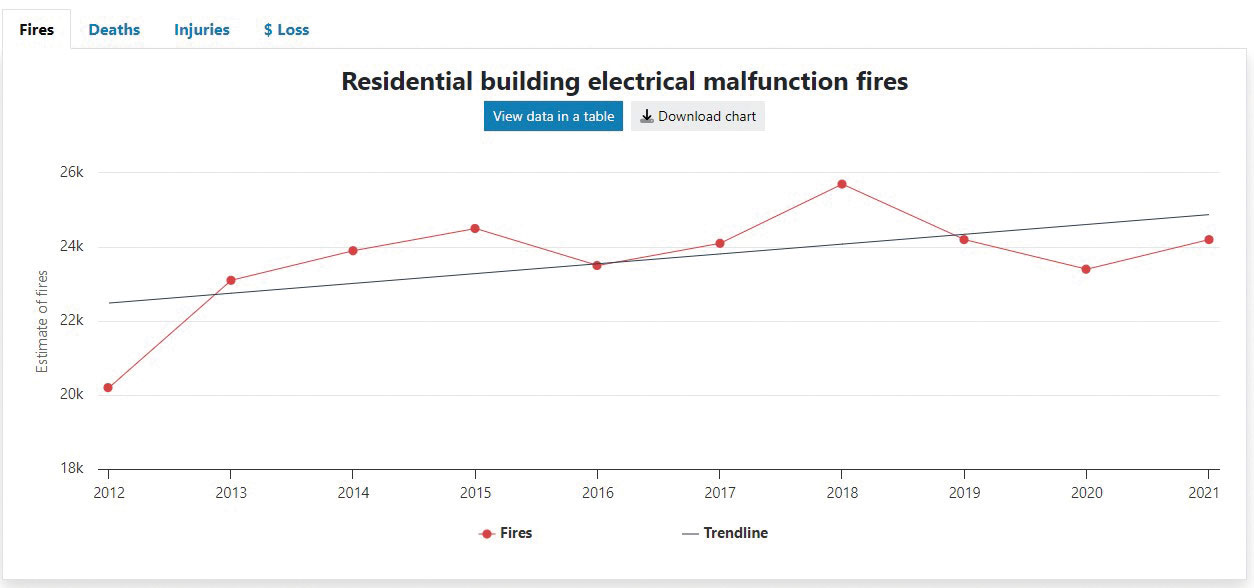

Overall Impact of AFCIs and Fire Prevention Efforts
Since the peak of annual residential fires in 1980 of 75,000 and the subsequent introduction of fire prevention technologies like AFCIs, improved construction materials and fire service awareness efforts, the numbers of fires, deaths and injuries have dropped dramatically by more than half in many cases, per the NFPA.
Most recently, USFA indicated that in 2021, fire departments reported 24,200 electrical fires specifically related to electrical malfunction resulting in 295 deaths, 900 injuries and $1,201,500,000 in property damage loss.18
The USFA also pointed out that while these types of fires increased by 11% from 2012 to 2023, the number of fatalities dropped by 17%. Conversely, a USFA report from 2007 through 2016 found a 22 percent drop in electrical fires. 19
While numbers may fluctuate due to a variety of factors, the USFA data indicates the majority of these fires are caused by electrical system failures, appliance defects, incorrectly installed wiring, misuse and poor maintenance of electrical appliances, and overloaded circuits and extension cords. All areas where AFCIs can detect problems if arcing occurs.
The fire departments reported three specific types of equipment played a leading role in the ignition of half of all residential electrical fires including electrical wiring, outlets and receptacles, and electrical branch circuits. Other types not listed in the USFA chart included extension cords (5 percent), panel (fuse) boards (4 percent), and other lamps and lighting (4 percent).
This data reinforces that while great strides have been made in dramatically lowering the number of residential fires and specifically electrical malfunction fires in homes, there is no absolute or certainty that the situation can still worsen if not monitored and addressed. The same diligence and commitment for safety that emerged in 1980 to address the surge in residential and electrical fires specifically should continue from the electrical, consumer safety, fire services and construction industries. While AFCI technology has provided a significant and proven component in protecting homeowners from electrical fires, it is one of many tools in a larger effort to keep these incidents from happening, saving lives and preventing injuries and property loss.
What’s Next?
It is clear that all industries working together have helped to greatly improve electrical safety and reduce residential electrical fires in the past 25 years since the introduction of AFCIs. The technology has earned its place as a proven life safety protection for residents by detecting and stopping dangerous arcing that can lead to fires. As innovation continues to improve and bring new safety protections to home construction in the future, it will be important for the various industries and state code adoption groups to continue to embrace NEC® requirements for AFCIs. These standards ensure that consumers are a top priority, and together, our industries share a common commitment to protecting their safety.
References
- NFPA Home Structure Fires Oct. 2019 https://www.maine.gov/future/sites/maine.gov.dps.fmo/files/inline-files/nfpa_home_structure_fires.pdf
- Siemens – AFCI History https://assets.new.siemens.com/siemens/assets/api/uuid:6d713093-b2ee-41e3-a015-ad35d853f1ab/sie-wp-afcihistory.pdf
- “Selected International Comparisons of Fire Loss,” by Jerry Banks and Ronald L. Rardin, Georgia Institute of Technology, December 1980.
- “Technology for Detecting and Monitoring Conditions that Could Cause Electrical Wiring Fires,” Underwriters Laboratories Inc., UL Project Number: NC233, 94ME78760, CPSC Contract Number CPSC-C-94-1112, September 1995
- CSPC – Ault, Singh, and Smith, “1996 Residential Fire Loss Estimates”, U.S. Consumer Product Safety Commission, Directorate for Epidemiology and Health Sciences, October 1998, Tables 1, 6, 10, and 14
- “New Technology for Preventing Residential Electrical Fires: Arc-Fault Circuit Interrupters (AFCIs),” by Douglas A. Lee et al, undated (circa 1999)
- NEMA LVDE AFCISafety.org website https://www.afcisafety.org/afci/why-afci/
- AFCIs Prevent Fires – Electrical Safety Foundation International https://www.esfi.org/arc-fault-circuit-interrupters-afcis-prevent-fires/#:~:text=Available%20as%20circuit%20breakers%20and,prevented%20by%20proper%20AFCI%20protection.
- “New Technology for Preventing Residential Electrical Fires: Arc-Fault Circuit Interrupters (AFCIs),” by Douglas A. Lee et al, undated (circa 1999)
- National Electrical Code Enforcement Map – NFPA https://www.nfpa.org/education-and-research/electrical/nec-enforcement-maps?l=50
- Fire in the United States Since 1980 – NFPA https://www.nfpa.org/news-blogs-and-articles/blogs/2022/05/04/new-fire-in-the-us-report-highlights-factors-that-have-reduced-loss-in-the-days?l=83
- NEC Code Changes for 2023 https://www.homedepot.com/c/ab/nec-2023-code-changes/9ba683603be9fa5395fab901e21904c9
- AFCI Issue Brief – AFCISafety.org https://www.afcisafety.org/wp-content/uploads/2018/08/AFCI-Issue-Brief.pdf
- Policy Institute Falling Behind Electrical Safety Report – https://www.afcisafety.org/wp-content/uploads/2018/04/PolicyInstituteFallingBehingElectricalSafetyReport.pdf
- 2023 Arc-Fault Circuit Interrupter & Ground-Fault Circuit Interrupter Performance Survey – ESFI https://www.esfi.org/2023-afci-and-gfci-performance-survey/
- NEMA AFCI Appliance White Paper https://www.nema.org/standards/view/arc-fault-circuit-interrupters-and-home-appliances?fbclid=IwAR1uX9HLmoZrlmMR7WhH99R1zcxdxVQO0KcG6QqfitI-TN-DuAcc8zr_CgQ
- NFPA Home Structure Fires https://www.maine.gov/future/sites/maine.gov.dps.fmo/files/inline-files/nfpa_home_structure_fires.pdf
- Residential Fire Statistics – USFA https://www.usfa.fema.gov/statistics/residential-fires/electrical.html
- Residential Building Electrical Fires (2014-2016) https://www.usfa.fema.gov/downloads/pdf/statistics/v19i8.pdf
For more information on AFCI technology, visit www.afcisafety.org
NEMA LVDE AFCI Task Force
National Electrical Manufacturers Association
1300 North 17th Street, Suite 900
Rosslyn, Virginia 22209

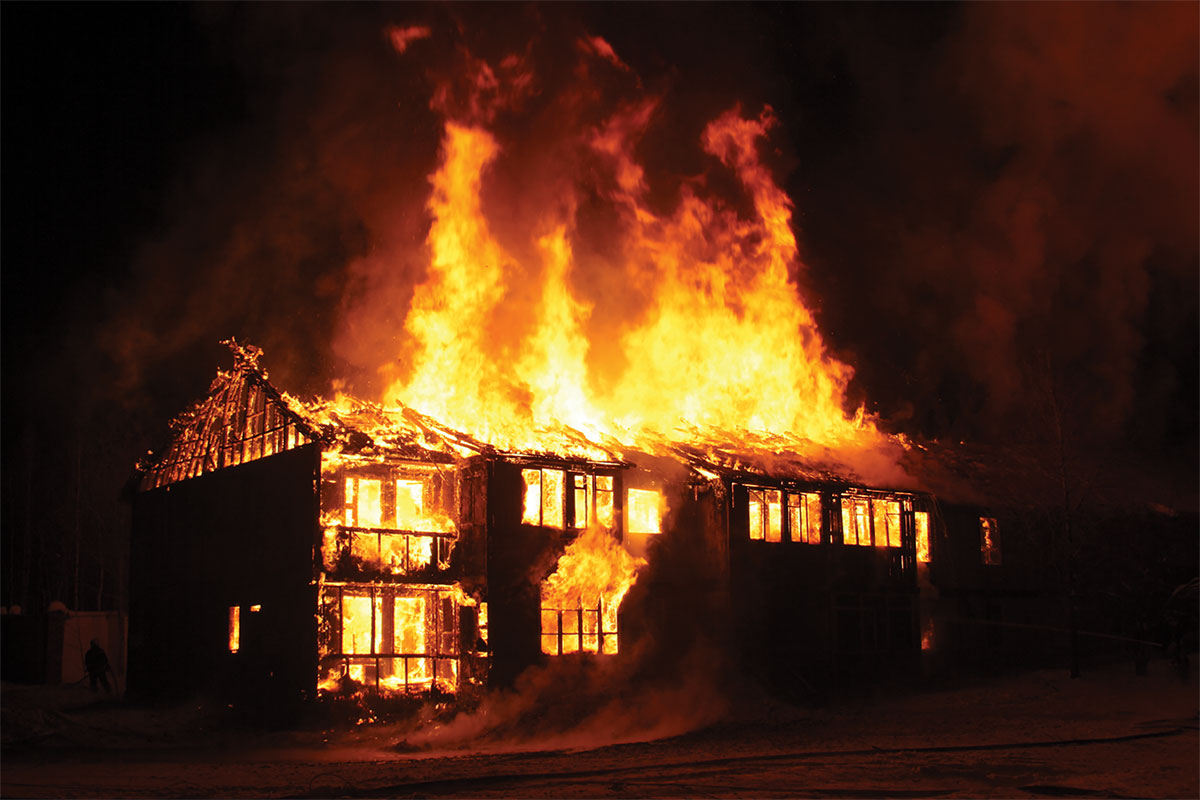


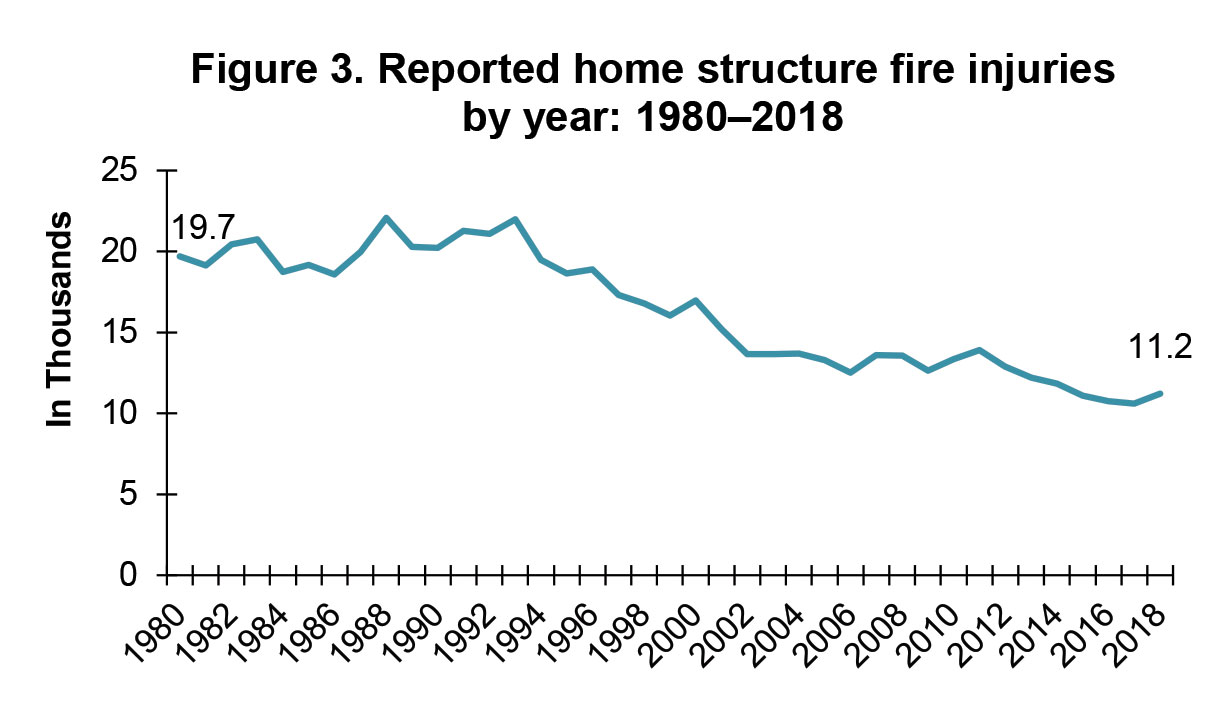
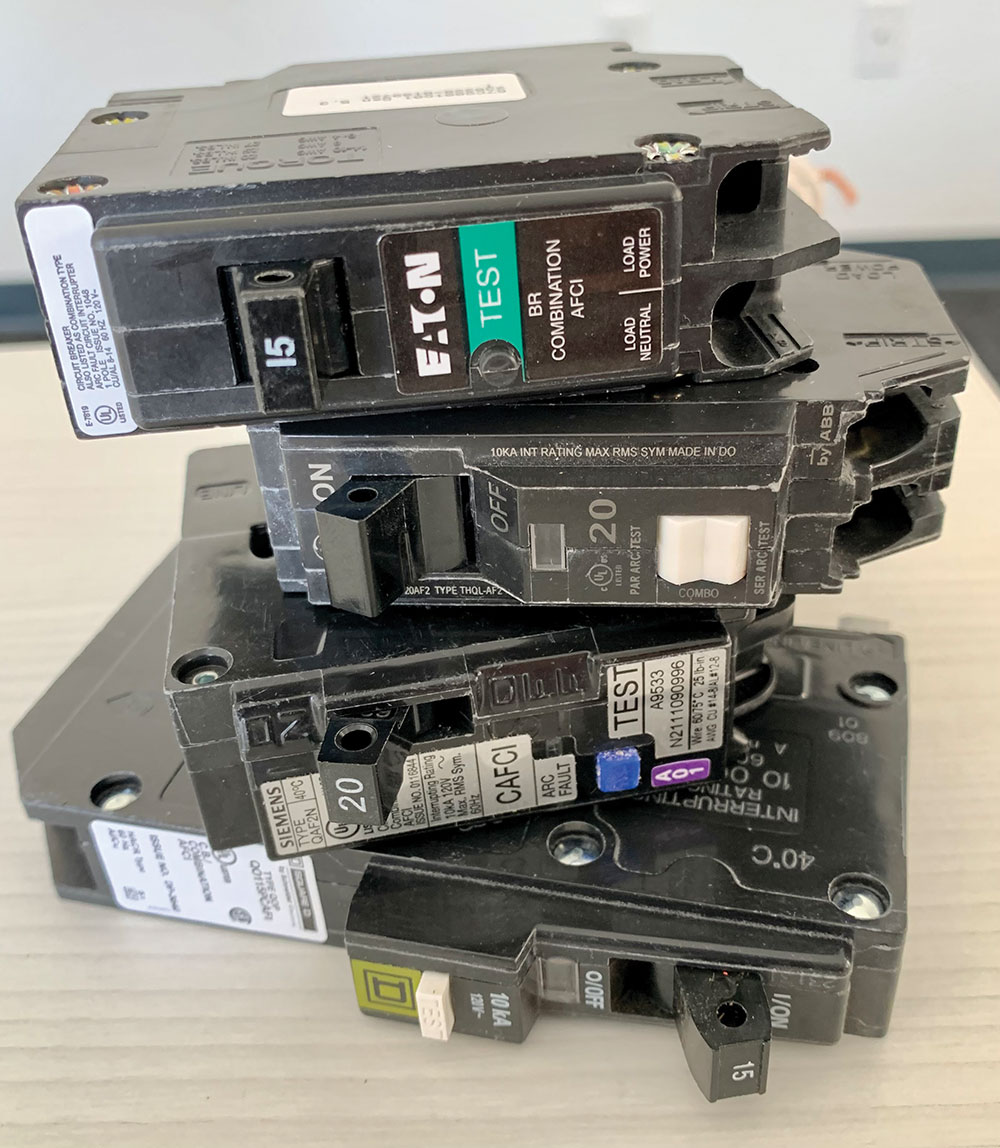






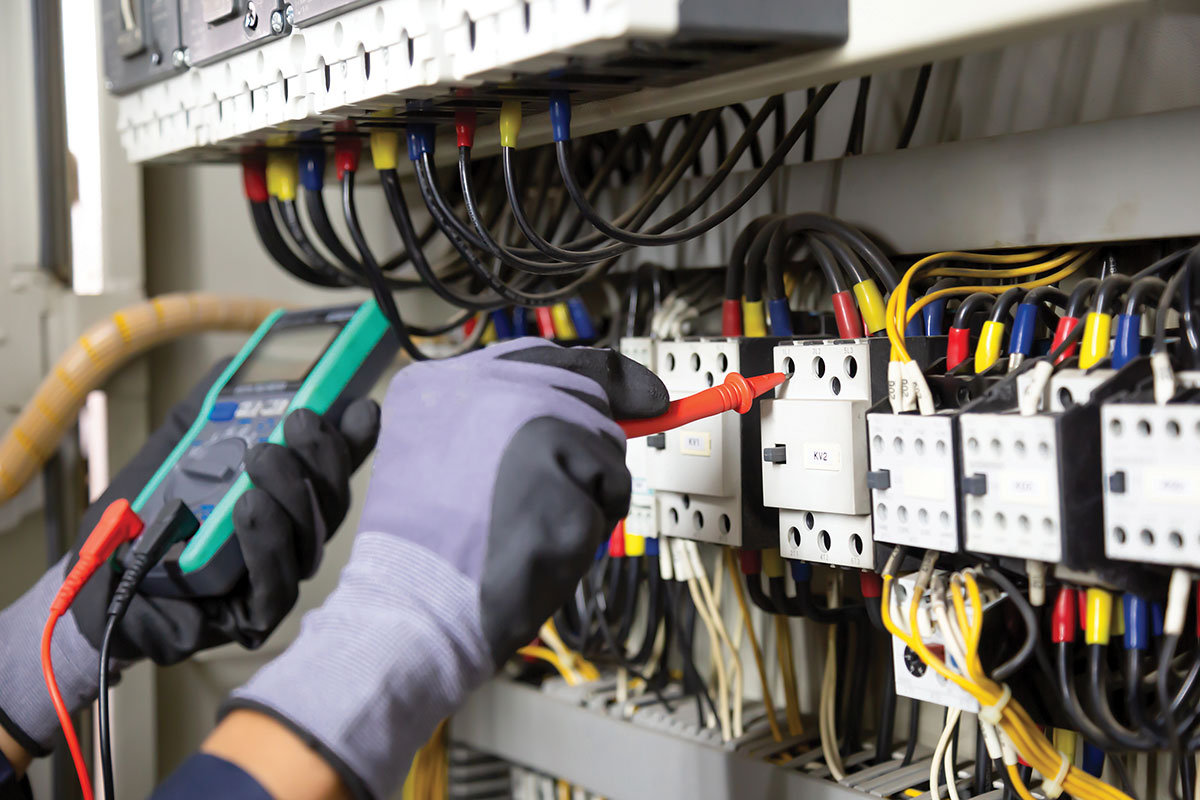
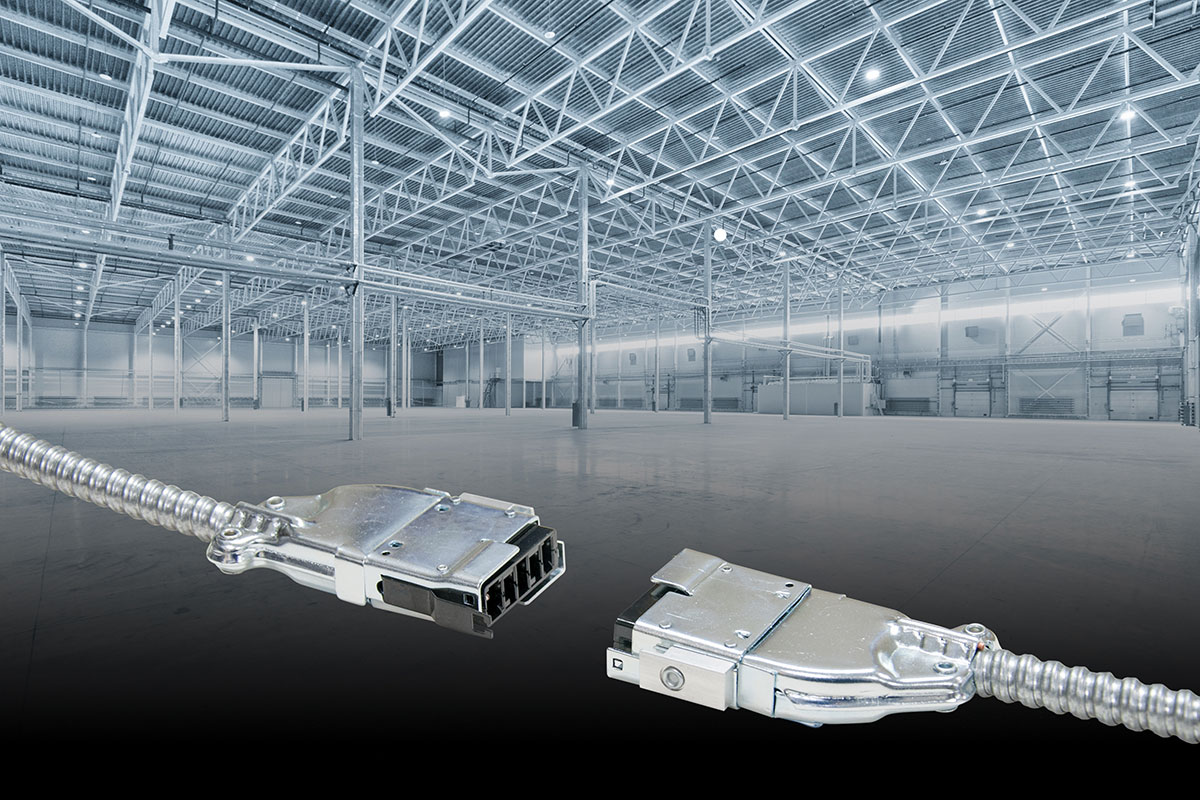

Find Us on Socials